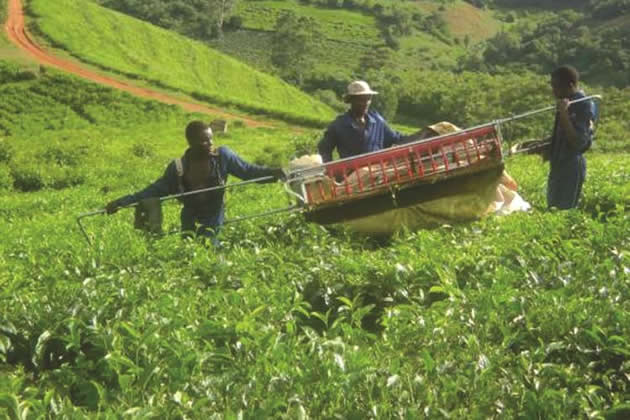Trends in agric, lessons

Charles Dhewa Review Correspondent
While the World Bank Doing Business Index and competitiveness issues monopolised policy discourse in 2015, big international corporations have quietly consolidated their position in Zimbabwe’s hybrid seed industry.
Dupont, Monsanto and Sygenta are the three big American companies that have intensified their strangehold in Zimbabwe’s seed industry. The recent acquisition of Pannar Seeds by Pioneer Seeds has been interpreted as a strong move by Dupont to consolidate its position on Zimbabwe’s seed industry since both Pannar and Pioneer are Dupont subsidiaries. On the other hand, the Seed Co-Limagrain deal represents French interests in Zimbabwe.
Although seemingly maintaining a low key, Monsanto and Sygenta are introducing their maize seed varieties into Zimbabwe through subsidiaries. Also in the maize seed game is a South African outfit known as K2 which recently swallowed Agriseeds. There is also a range of small players such as ARDA Seeds, Mukushi, Zaka Seeds and Sandbrite Seeds.
Curious questions
The above developments trigger two critical questions: Why is there such a stampede into the maize seed industry when the market for maize grain is declining?
Why hasn’t the horticulture industry enjoyed the same stampede as maize when maize meal is consumed with vegetables? Challenges facing the Grain Marketing Board (GMB) have resulted in maize grain marketing being taken over by the people’s market. At least 90 percent of the maize grain is in the hands of the people’s market from district, provincial and national markets like Mbare.
The people’s market is also distributing maize directly to sole trader millers and milling companies in urban centres. Overall, more than 60 percent of agro-formal companies’ sustenance is in the people’s market.
According to some market observers, the main reason why giant global players in the maize seed industry are coming to Zimbabwe is because of the US dollar. Basically they are coming in to sweep foreign currency from the country and use it to strengthen their investments in other countries.
Although some farmers felt the coming in of many players in the maize seed industry created healthy competition, others felt corporate mergers among seed companies lead to the creation of oligopolies which kill diversity, resulting in anti-competitive behaviour.
However, some horticulture farmers said the coming in of Limagrain into Seed Co can be a blessing for the vegetable seed industry where there is currently no big player. This is because Limagrain is considered a big player in the vegetable seed market in Europe.
What explains lack of consistency in
production among many farmers?
During the first year, the farmer mobilises all the help s/he can find in the form of labour, commits a lot of resources and follows all the advice from other farmers and extension officers.
In the second year, the farmer starts to cut corners since s/he thinks s/he now has the knowledge. Experimentation kicks in with the farmer beginning to use less fertiliser and chemicals.
In the third year, the farmer wants to correct mistakes made in the second year so that s/he goes back to first year performance levels. S/he manages to improve more than second year but does not reach first year performance levels. In the fourth year, the farmer has lost a lot of resources and thus remains at lower standards. At this stage, withdrawal syndrome sets in. All sorts of excuses come in as revealed through blaming farm management, politics and markets, all to justify an exit decision.
Another reason why farmers have failed to maintain commendable consistency is trying to be venturesome, for example, transitioning from tobacco to horticulture with little knowledge. If a farmer maintains first year standards and acquires advice to maintain that level, s/he should also have an appetite for research in order to keep improving.
Labour issues going into the future
Lack of labour is already affecting farmers and the situation is likely to worsen. Previous white farmers deliberately kept farm labourers illiterate and not mobile so that they remained a consistent pool of labour. Grade Five was the highest level of education for children of farm labourers so that the they were just able to count things on the farm but not be ambitious enough.
Grocery shops and beer hall services were provided on the farm so that labourers would not find any reason to travel outside the farm.
Come land reform, some children of farm labourers have become educated and highly mobile. The majority now own mobile phones. Having been liberated from colonial bondage through the land reform, farm labourers now know their rights and demand more than can be provided by new farm owners. Some now prefer to operate their own small beer halls at the farm, sell airtime cards and drive kombis to urban centres.
Casualisation of labour and piece-work have become a common phenomenon as farm workers no longer want to be tied to one place and committed to wage labour.
According to new farmers, the labourers can actually tell you how much they want to be paid for a given task unlike in the past where fear-mongering was used to get them working.
Under these circumstances, mechanisation is long overdue. Smart technology like drip irrigation is urgently needed to address some of these challenges. In five to six years from now, this problem is going to worsen to a point of requiring Government intervention. Mechanisation is going to save smallholder agriculture from collapse in the future.
The extent to which the formal and
informal markets depend on each other
Most formal processing companies like Cairns used to depend on large scale farms under contractual arrangements. Following the land reform, many smallholder farmers with small plots rely on the people’s market as their main demand zone. Traders pull commodities from farming areas to the people’s market from which they supply formal companies. This is more cost effective for formal companies because they don’t need to mobilise commodities from smallholders dotted around wards and districts.
Traders also grade and sort commodities to meet specifications of formal companies like supermarkets. The people’s market ensures consistency in supply for companies unlike under contractual arrangements where supplies can run out due to unforeseen circumstances.
Eighty percent of formal companies in Zimbabwe obtain fresh produce from the people’s market. The retail market comprises vendors from high density areas. Through vendors (retailers) the people’s market feeds 80 percent of low to medium density urban population.
The remaining 20 percent is covered by small backyard gardens. Food chain stores and restaurants account for 20 percent of produce from the people’s market. This group services formally employed low density populations, including those working in the central business district.
In Zimbabwe, Mbare agriculture market remains the distribution hub for horticultural produce from the northern part of Zimbabwe to other parts of the country, mainly the southern part. It also pulls drought tolerant field crops (small grains from dry areas such as Buhera, Chivi and Mwenezi to the northern part of the country.
The benefits of knowledge gap analysis
Agricultural evidence gathering processes should try to build from a formal product rather than collecting information from farmers only and going ahead to analyse the data. Food that reaches the market is 100 percent for consumption unlike in farms where there can be many uses including livestock feeding and exchanging for labour.
When researchers collect samples from storage facilities and farms, they pretend to know all the uses for those products. The shortfalls of a product are seen in the market where it competes with other products from elsewhere.
It is therefore important to take samples from the market if one is to correctly advise farmers. The product has to meet certain standards thus the market offers a feedback mechanism and a structure for participation.
This will avoid a situation where researchers put the market in a panic mode by linking aflatoxins to cancer.
Fear-mongering is not a smart marketing strategy. It should merely be about quality control rather than raising unnecessary alarm.
- [email protected] / [email protected] / [email protected] Website: www.emkambo.co.zw / www.knowledgetransafrica.com eMkambo Call Centre: 0771 859000-5/ 0716 331140-5/ 0739 866 343-6










Comments